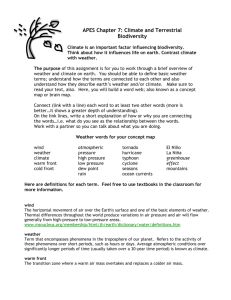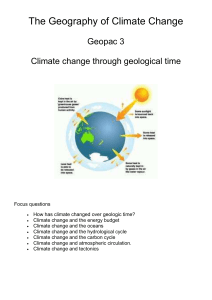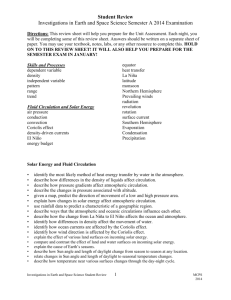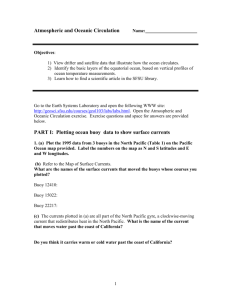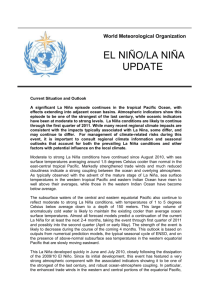Chapter 4
advertisement
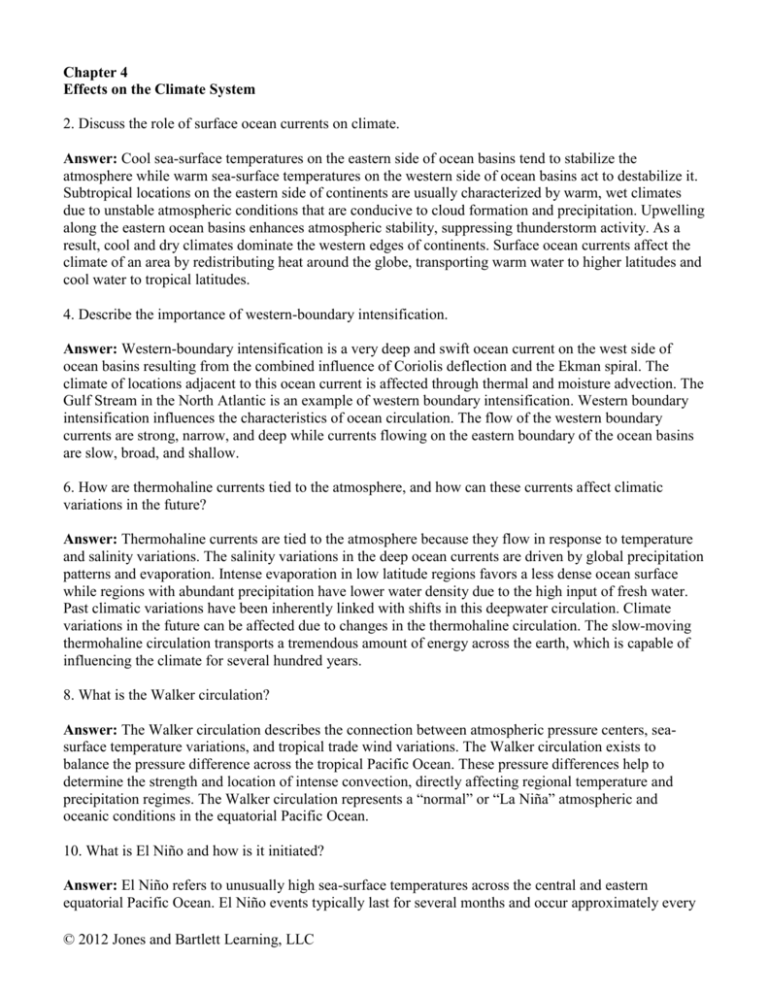
Chapter 4 Effects on the Climate System 2. Discuss the role of surface ocean currents on climate. Answer: Cool sea-surface temperatures on the eastern side of ocean basins tend to stabilize the atmosphere while warm sea-surface temperatures on the western side of ocean basins act to destabilize it. Subtropical locations on the eastern side of continents are usually characterized by warm, wet climates due to unstable atmospheric conditions that are conducive to cloud formation and precipitation. Upwelling along the eastern ocean basins enhances atmospheric stability, suppressing thunderstorm activity. As a result, cool and dry climates dominate the western edges of continents. Surface ocean currents affect the climate of an area by redistributing heat around the globe, transporting warm water to higher latitudes and cool water to tropical latitudes. 4. Describe the importance of western-boundary intensification. Answer: Western-boundary intensification is a very deep and swift ocean current on the west side of ocean basins resulting from the combined influence of Coriolis deflection and the Ekman spiral. The climate of locations adjacent to this ocean current is affected through thermal and moisture advection. The Gulf Stream in the North Atlantic is an example of western boundary intensification. Western boundary intensification influences the characteristics of ocean circulation. The flow of the western boundary currents are strong, narrow, and deep while currents flowing on the eastern boundary of the ocean basins are slow, broad, and shallow. 6. How are thermohaline currents tied to the atmosphere, and how can these currents affect climatic variations in the future? Answer: Thermohaline currents are tied to the atmosphere because they flow in response to temperature and salinity variations. The salinity variations in the deep ocean currents are driven by global precipitation patterns and evaporation. Intense evaporation in low latitude regions favors a less dense ocean surface while regions with abundant precipitation have lower water density due to the high input of fresh water. Past climatic variations have been inherently linked with shifts in this deepwater circulation. Climate variations in the future can be affected due to changes in the thermohaline circulation. The slow-moving thermohaline circulation transports a tremendous amount of energy across the earth, which is capable of influencing the climate for several hundred years. 8. What is the Walker circulation? Answer: The Walker circulation describes the connection between atmospheric pressure centers, seasurface temperature variations, and tropical trade wind variations. The Walker circulation exists to balance the pressure difference across the tropical Pacific Ocean. These pressure differences help to determine the strength and location of intense convection, directly affecting regional temperature and precipitation regimes. The Walker circulation represents a “normal” or “La Niña” atmospheric and oceanic conditions in the equatorial Pacific Ocean. 10. What is El Niño and how is it initiated? Answer: El Niño refers to unusually high sea-surface temperatures across the central and eastern equatorial Pacific Ocean. El Niño events typically last for several months and occur approximately every © 2012 Jones and Bartlett Learning, LLC three to seven years. An El Niño is initiated when strong surface trade winds in the tropics weaken or become reversed along the equator. This allows the warm water in the western Pacific to flow eastward. 12. Describe the changes in the overlying atmosphere during an El Niño event. Answer: During an El Niño event, the tropical easterly trade winds weaken or become reversed. The surface low pressure system in the western Pacific migrates eastward, allowing high-pressure to build over the western tropical Pacific. The reversal of the usual pressure patterns during El Niño events causes atmospheric circulation to readjust on a planetary scale. The relatively high pressure that normally persists over southwest Africa switches to lower atmospheric pressure, resulting in an area of low-pressure over the equatorial Indian Ocean. Eastern Indonesia and northeastern Australia experience above normal pressures during an El Niño event while lower than average pressure is observed over northwestern Australia. The amplitude of the polar front jet stream tends to increase and sometimes may split into two distinct branches across the U.S. during an El Niño event. 14. What is a La Niña event and why is it significant? Answer: A La Niña event is considered to be an extreme version of the normal Walker circulation. During a La Niña the strength of the trade winds increases along the equatorial Pacific Ocean, preventing the eastward migration of the warm western Pacific waters. These conditions allow water to “pile up” in the western Pacific and enhance cold water upwelling in the eastern Pacific. As a general rule La Niña events act to strengthen normal atmospheric circulation patterns across the tropics. Devastating ecological and economic problems can result from this disruption in circulation. Recent research indicates that a La Niña event may have as much or more influence on precipitation in the southern U.S. as compared to an El Niño event. La Niña events are also associated with more active hurricane seasons in the Atlantic basin. 16. Discuss the role of volcanism relative to short-term and long-term climatic change and variability. Answer: The composition of the atmosphere is linked to volcanic activity. The gases, primarily SO2, and atmospheric aerosols emitted by volcanoes can trigger either a net cooling or warming of the atmosphere. Volcanic smog, or vog, from major eruptions can significantly reduce the percentage of incoming solar radiation reached at the earth’s surface for up to four years. Volcanic activity affects long-term climatic change only during prolonged periods of above-normal activity. Individual volcanoes are capable of altering hemispheric and global climates over relatively short time periods. 18. How do atmospheric changes drive processes in the cryosphere? Answer: Atmospheric changes drive processes in the cryosphere by providing the conditions necessary for glacial advance and retreat. Glacial advances occur during cooler and/or wetter periods, while glacial retreat occurs during warmer and/or drier periods. Summer temperatures generally determine whether glacial advance or retreat is occurring. Cool, short summers provide the optimal conditions for glacial advance while long, warm summers are conducive for glacial retreat. Because planetary temperatures have generally increased over the last 10,000 years or so, most of the ice has been retreating poleward and/or uphill. © 2012 Jones and Bartlett Learning, LLC


